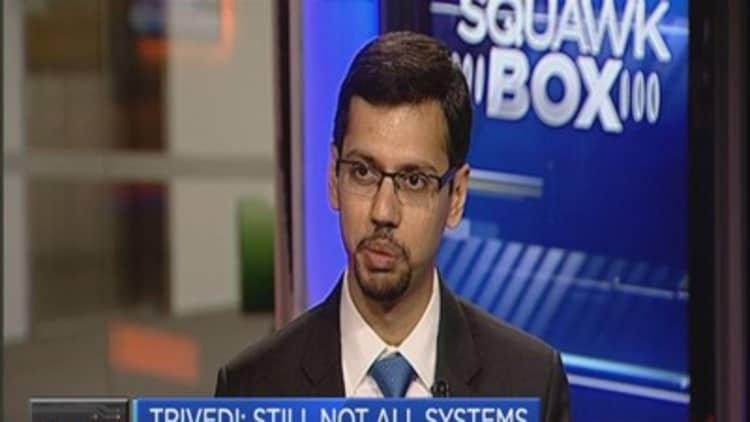The good news: a turbulent year for emerging markets (EM) that saw assets from Jakarta to Johannesburg get walloped is coming to an end. The bad news: prospects for 2016 do not look very appealing either, according to JPMorgan.
In its 2016 emerging markets outlook and strategy note, JPMorgan has listed 10 key investment themes for fixed-income assets in emerging markets.
Here they are:
Low single-digit returns in EM fixed income next year
A likely interest rate increase from the U.S. Federal Reserve, lower commodity prices and a stronger dollar will conspire to create headwinds for EM in the first half of 2016, the bank notes.
Returns on EM government and corporate debt are likely to be a puny 1-3 percent, the bank estimates. Returns on local currency debt could be 3.7 percent for the year, providing external factors improve in the second half of the year.
No light at the end of the tunnel for EM growth
The bank forecasts EM economic growth of 3.7 percent in 2016, admittedly higher than the 3.4 percent expansion this year but a forecast that suggests most EM countries will be growing at a clip well short of their potential.
On a less gloomy note, the overall current account position (excess of exports over imports in goods and services plus net transfers and net income) is forecast to be in surplus at 1.4 percent of gross domestic product. But lower commodity prices and potential capital outflows could still weigh on foreign exchange reserves.
Divergence to persist among regions

The belief that EM was an asset class with highly homogeneous countries that all moved in tandem has been busted in recent years. Expect this trend to get more pronounced.
EM Asia GDP growth is is pegged at 5.8 percent in 2016, the slowest pace of expansion since 2001. Growth in EM countries in the Europe, the Middle East and Africa (EMEA) region will be nearly twice that of this year at 2.0 percent.
Recessions in Brazil and Venezuela will mean output in Latin America as a whole ends up contracting when compared with 2015.
Growth in China is expected to slow further
The slowdown in China and the botched response to a rout in its (arguably frothy) stocks gripped financial markets in mid-2015. As the economy rebalances to one that is less dependent on manufacturing and relies more on services, growth will be slower at 6.6 percent.
Waning appetite for commodities also spells bad news for EM countries that benefited from flogging commodities such as copper and iron ore to China.
Monetary policy support in EM will be very limited
Inflation is expected to edge higher in EM Asia as commodity prices normalize and the impact of currency weakness on imported prices kicks in. In EMEA, with Russia projected to report single-digit inflation, the average should ease somewhat. Weak growth in Latin America should also keep a lid on prices.
JPMorgan expects interest rate increases in Chile, Colombia, Hong Kong, Mexico, Peru, Turkey and South Africa next year. Small cuts are possible in Hungary, Philippines, Poland and Thailand, with some normalization from high rates in Russia.
The average EM policy rate will likely be flat, JPMorgan reckons.
EM external debt crisis seems unlikely
An increase in corporate debt is a source of concern in EM. Non-financial corporate debt is pegged at 76.2 percent of GDP across EM in 2015, compared with 48.4 percent of GDP for government debt and 29.5 percent of GDP for household debt.
As most of the buildup in corporate debt is domestic debt in the form of private sector loans, market participants will pay close attention to EM banks. Sovereign indebtedness is estimated to grow more modestly, allaying worries over an external sovereign debt crisis.
No inflows into EM bond funds over 2016
Money managers running EM fixed income funds are girding for record outflows this year.
With returns expected to be subdued in 2016 as well, retail outflows (typically highly correlated with EMs returns) from EMs funds should end, JPMorgan notes. But there is a material risk that the institutional strategic outflows recorded in Q3 2015 from local currency mandates may continue.
Potential opportunities in H2 2016
Volatility in EMs assets will stay high going into the new year, the bank reckons.
The first half of 2016 is not likely to be clement for EM fixed income for reasons previously mentioned, but as the expected rally in the dollar fades (due to the Fed lifting rates more slowly than market participants currently expect), there could be bargains to be snapped.
Spreads to widen on EM foreign-currency debt
Despite the wobbles in EM in 2015, foreign-currency debt in 2015 fared better than many other assets, including U.S. equities, global government bonds and U.S. junk debt.
In 2016, investors will demand higher compensation for the risk of holding EM debt over safe haven assets due to weak growth in the region, concerns over indebtedness and the likely increase in default rates for risky borrowers in EM countries. The EM high yield corporate default rate is projected to increase to 3.5% in 2016 from unexpectedly low 2.9% this year, according to the bank.
JPMorgan expects spreads on its sovereign bonds index to climb 40 basis points to 425 basis points over U.S. Treasuries. A basis point is 1/100th of a percentage point. The spreads on its EM corporate bond index is forecast to rise by a similar magnitude to 450 basis points.
Underweight Asia, overweight EMEA
In the local bonds/rates space, JPMorgan is staying neutral Latin America with an underweight relative to benchmarks in EM Asia duration and an overweight position in eastern Europe.
The bank expects Eastern European debt to benefit from further asset purchases by the European Central Bank as yields on euro-zone debt fall further, spurring investors to look elsewhere to pocket returns.
In EM corporate debt, JPMorgan prefers Asia to EMEA EM or Latin America for now.




